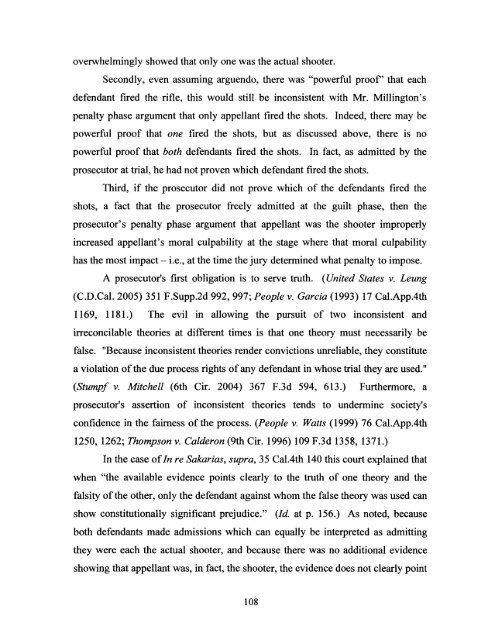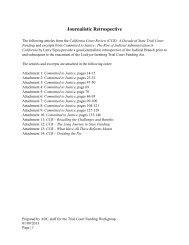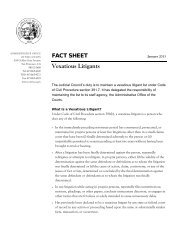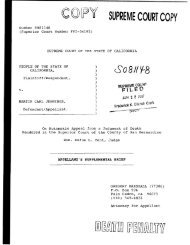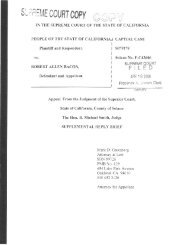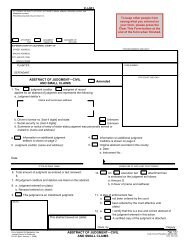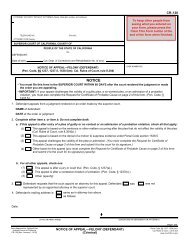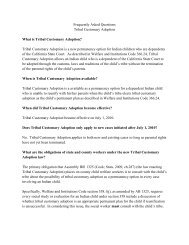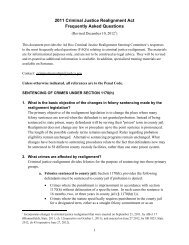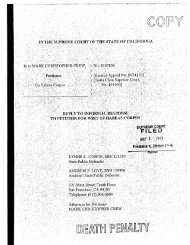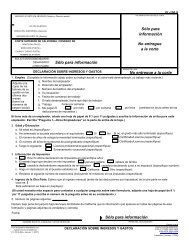Appellant, William Satele, Reply Brief - California Courts - State of ...
Appellant, William Satele, Reply Brief - California Courts - State of ...
Appellant, William Satele, Reply Brief - California Courts - State of ...
Create successful ePaper yourself
Turn your PDF publications into a flip-book with our unique Google optimized e-Paper software.
overwhelmingly showed that only one was the actual shooter.<br />
Secondly, even assuming arguendo, there was "powerful pro<strong>of</strong>' that each<br />
defendant fired the rifle, this would still be inconsistent with Mr. Millington's<br />
penalty phase argument that only appellant fired the shots. Indeed, there may be<br />
powerful pro<strong>of</strong> that one fired the shots, but as discussed above, there is no<br />
powerful pro<strong>of</strong> that both defendants fired the shots. In fact, as admitted by the<br />
prosecutor at trial, he had not proven which defendant fired the shots.<br />
Third, if the prosecutor did not prove which <strong>of</strong> the defendants fired the<br />
shots, a fact that the prosecutor freely admitted at the guilt phase, then the<br />
prosecutor's penalty phase argument that appellant was the shooter improperly<br />
increased appellant's moral culpability at the stage where that moral culpability<br />
has the most impact - i.e., at the time the jury determined what penalty to impose.<br />
A prosecutor's first obligation is to serve truth. (United <strong>State</strong>s v. Leung<br />
(C.D.Cal. 2005) 351 F.Supp.2d 992, 997; People v. Garcia (1993) 17 Cal.AppAth<br />
1169, 1181.) The evil in allowing the pursuit <strong>of</strong> two inconsistent and<br />
irreconcilable theories at different times is that one theory must necessarily be<br />
false. "Because inconsistent theories render convictions unreliable, they constitute<br />
a violation <strong>of</strong>the due process rights <strong>of</strong>any defendant in whose trial they are used."<br />
(Stumpf v. Mitchell (6th Cir. 2004) 367 F.3d 594, 613.) Furthermore, a<br />
prosecutor's assertion <strong>of</strong> inconsistent theories tends to undermine society's<br />
confidence in the fairness <strong>of</strong> the process. (People v. Watts (1999) 76 Cal.AppAth<br />
1250, 1262; Thompson v. Calderon (9th Cir. 1996) 109 F.3d 1358, 1371.)<br />
In the case <strong>of</strong>In re Sakarias, supra, 35 Ca1.4th 140 this court explained that<br />
when ''the available evidence points clearly to the truth <strong>of</strong> one theory and the<br />
falsity <strong>of</strong>the other, only the defendant against whom the false theory was used can<br />
show constitutionally significant prejudice." (Id. at p. 156.) As noted, because<br />
both defendants made admissions which can equally be interpreted as admitting<br />
they were each the actual shooter, and because there was no additional evidence<br />
showing that appellant was, in fact, the shooter, the evidence does not clearly point<br />
108


